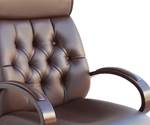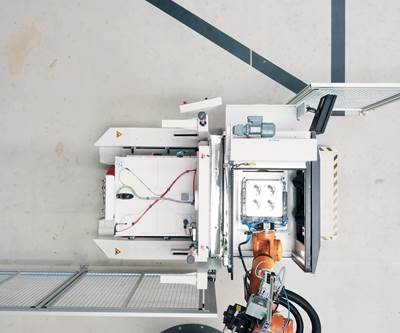Project Partners Bring Next Generation AM Project to Successful Conclusion
Two years after Daimler, Premium Aerotec and EOS launched their NextGenAM pilot manufacturing facility in Varel, Germany, the partners now celebrated the successful completion of the project during a special ceremony in Varel, Germany.
With the completion of the "NextGenAM" project for the development of a pilot production line for a next-generation automated additive manufacturing (AM) process, project partners Daimler, Premium Aerotec and EOS agree they have reached an important milestone in the industrialization of AM. "We are only at the beginning, but we are at a tipping point," says Dr. Thomas Ehm, chairman of the executive board of Premium Aerotec. "The successful conclusion of NextGenAM thus represents another important building block in our strategy."
The aim of the pilot project was to develop a digitalized next-generation additive manufacturing line which would be able to produce aluminum components for the automotive and aerospace sectors significantly more cost-effectively than was so far possible. While the AM factory is not producing series parts yet, the pilot facility—located at Premium Aerotec in Varel, Germany—is today already capable of the automated manufacturing of components to series-production quality standards.
For example, parts for Daimler are already being produced on the new technology line at Premium Aerotec include a bracket for a truck diesel engine as a spare part (see the last photo in the slideshow above). The first requests for 3D printed replacement bus parts in aluminum are currently being examined at the Centre of Competence for 3D printing at Daimler Buses. The analysis team in the passenger car area is also currently considering suitable potential applications.
According to Ehm, the overall production process at Premium Aerotec could reduce manufacturing costs by up to 50% compared with existing 3D printing systems. And the company, a subsidiary of European aircraft manufacturer Airbus and a manufacturer of aerostructures in its own right, has been a key adopter of additive manufacturing technologies in the aerospace sector. In 2015 Premium Aerotec opened a manufacturing facility dedicated entirely to AM. In 2016, the company got approval from German certification board EASA to additively manufacture titanium parts for serial production of its A400M military aircraft. It is also producing bionically inspired parts for Airbus’ A350 program.
"As far as the aircraft industry is concerned, Premium Aerotec is today already an international pioneer in the field of metallic 3D printing. The aim now is to build further on this expertise and to bring it to bear in other sectors as well," Ehm says.
For aerospace suppliers, a low buy-to-fly ratio (the ratio of material inputs to final part output) is essential to generate maximum profit, so the more processes can be carried out simultaneously during AM production, the better. The laser has to ideally work 24/7.
Scalable Automated AM Production Chain
The secret to the NextGenAM factory lies in an ingenious and scalable additive production chain, which is fully automated right through to the point where the 3D printed parts are mechanically sawn off the build platform. No manual work is now required at any stage of the process, from the data preparation and central powder supply through to the AM build process itself and including heat treatment, quality assurance and separation of the components from the build platform. To maximize safety and traceability, powder handling is performed in a closed circuit and the powder is fed to the machine during the metal 3D printing process.
This process happens on an EOS M 400-4 four-laser system for industrial 3D printing. While the machine can print a variety of metals, the pilot plant processes high-strength aluminum/magnesium/scandium alloy (also known as Scalmalloy) for parts used in the aviation and aerospace sectors. For the automotive sector a classic aluminum alloy (AlSi10Mg) is used, the material properties of which have been continually improved over the course of the pilot project. According to EOS, the material strength and finish quality, among other factors, have been significantly improved compared with two years ago when the cooperation started.
All the machines used are networked, and a driverless transport system and robots ensure the smooth movement of the parts through every stage of the production line. The entire production process runs itself, without operating personnel, from a central, autonomous control center. The build job data is transmitted to the control center, which then prioritizes the various build requests and allocates them to an AM system. During the build process, the manufacturing status can also be retrieved on a mobile device, independent of location. Once the full production chain has been completed, the quality reports are sent back to the central control center.
All the data necessary for the production of a digital "twin" can be accessed here, allowing complete traceability. There are interfaces to ERP and PLM systems and from design to simulation; the engineers use CATIA for aerospace parts and Siemens NX for automotive.
According to Premium Aerotec, the continuous 3D data string with integrated quality management makes this production system one of the first examples of the benchmark for the future, Industry 4.0. The manufacturing process is completely scalable: The production lines can simply be duplicated to extend the capacity of the plant. This brings the promise of further substantial savings in the future as the numbers rise.
The Future: Where from Here?
Today, the pilot facility is already capable of the automated manufacturing of components to series-production quality standards. According to Jasmin Eichler, head of future technologies at Daimler AG, the facility is suitable for smallest-series production of new, limited edition vehicles; development of new vehicles; and production of the integrated base plates that carry the cooling lines for the batteries in electric vehicles, for instance.
Components for new vehicles can be optimized for 3D printing during the design phase, bringing the promise of further advantages in terms of cost. 3D printing also delivers weight savings, which are of particular interest for electric vehicles. When it comes to replacement parts, 3D printing brings the advantage of saving warehousing costs going forward, because parts can instead be produced "on demand." This vision for the future is also known at Daimler as "Digital Stock"; in other words, the centralized availability of digital manufacturing data allows for the decentralized production of replacement parts using 3D printing.
Currently, preparations are under way for an audit according to the requirements of the stringent industry standard VDA 6.3. This is one of the prerequisites at Daimler for the supply of series-production components by contract printing suppliers. The automation of the entire AM production chain will make it possible to manufacture larger batches in series production in the future, with the same reliability, functionality, durability and economic efficiency as conventionally manufactured components.
“We are at a point where we can start to learn what it means to industrialize AM together with digitalization, new materials and artificial intelligence.”
“Together with our partners we have reached this milestone and we have not yet agreed on how we will proceed with this project, but I can imagine to continue the project,” Eichler says.
Ehm agreed and emphasized his support for the idea of partnering with companies from various industry sectors, as Daimler, EOS and Premium Aerotec have done here. “The cooperation has worked really well. But we still have to analyze a couple of results and have consciously taken our time to decide how to proceed from here,” he says.
“We are very proud of what we have been able to achieve in collaboration with our partners Premium Aerotec and Daimler,” says Dr. Adrian Keppler, CEO of EOS. “We will continue. We are convinced that this is the future. In my opinion, we have created something unique. We are at a point where we can start to learn what it means to industrialize AM together with digitalization, new materials and artificial intelligence. If we all meet here again in two years, I hope not to see this one automated cell in operation but rather 10 or 20 of the same production cells, printing automotive as well as aerospace parts.”
Read Next
NextGenAM Pilot Facility Opens in Germany
The NextGenAM partnership, which includes Daimler, Aerotec and EOS, has launched its first pilot manufacturing facility in Varel, Germany.
Read MoreWhat Your CEO Needs to Know About Additive Manufacturing
Additive manufacturing promises to affect far more than manufacturing alone. When evaluating AM, the perspective needed is the view that sees the impacts all across the enterprise.
Read MorePostprocessing Steps and Costs for Metal 3D Printing
When your metal part is done 3D printing, you just pull it out of the machine and start using it, right? Not exactly.
Read More













